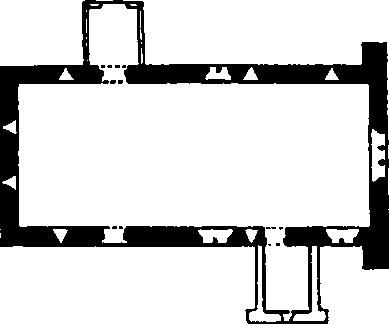An Inventory of the Historical Monuments in Essex, Volume 2, Central and South west. Originally published by His Majesty's Stationery Office, London, 1921.
This free content was digitised by double rekeying. All rights reserved.
'Ulting', in An Inventory of the Historical Monuments in Essex, Volume 2, Central and South west(London, 1921), British History Online https://prod.british-history.ac.uk/rchme/essex/vol2/pp236-237 [accessed 2 April 2025].
'Ulting', in An Inventory of the Historical Monuments in Essex, Volume 2, Central and South west(London, 1921), British History Online, accessed April 2, 2025, https://prod.british-history.ac.uk/rchme/essex/vol2/pp236-237.
"Ulting". An Inventory of the Historical Monuments in Essex, Volume 2, Central and South west. (London, 1921), British History Online. Web. 2 April 2025. https://prod.british-history.ac.uk/rchme/essex/vol2/pp236-237.
In this section
95. ULTING. (G.b.)
(O.S. 6 in. (a)xliv. S.E. (b)xlv. S.W. (c)liii. N.E.)
Ulting is a small parish 3 m. N.W. of Maldon.
Ecclesiastical
a(1). Parish Church of All Saints stands at the S.W. end of the parish. The walls are of flint and puddingstone-rubble with dressings of freestone; the roofs are tiled. The Chancel and Nave were both built early in the 13th century, but the the base of the walls may possibly be of earlier date. The church was extensively restored in 1873, and the North Porch and South Vestry are modern.
The unusual position of the piscina is noteworthy.

The Church, Plan
Architectural Description—The Chancel (17 ft. by 18½ ft.) is undivided structurally from the nave and has in the E. wall a three-light window all modern except for the internal splays and some stones of the segmental-pointed rear-arch, which are probably of the 15th century. In the N. wall are two early 13th-century lancet windows with rebated and chamfered jambs and head. In the S. wall are two windows,; the eastern is modern except for parts of the internal jambs, which are of the 15th century; the western window is similar to the windows in the N. wall, but it is partly restored and has a chamfered rear-arch; between the windows is a doorway, modern except for the internal splays and chamfered segmental-pointed rear-arch, which are possibly of the 13th century.
The Nave (27½ ft. by 18½ ft.) has in the N. wall two windows; the eastern is of two cinque-foiled lights with tracery in a two-centred head, all modern outside, but inside of late 14th-century date; the western window is a 13th-century lancet window, similar to those in the N. wall of the chancel; between the windows is the N. doorway, all modern except for the re-worked internal stones. In the S. wall are two windows and the S. doorway, all uniform with the corresponding windows and doorway in the N. wall. In the W. wall are three modern windows.
The Roof of the chancel has 15th-century wall-plates, and at the W. end an early 16th-century cambered and moulded tie-beam grooved on the under side, probably for a tympanum for the former rood. The 14th-century braced collar-beam roof of the nave has one truss with curved and hollow-chamfered principals; the other collars are braced.
Fittings—Bell: one, by Miles Graye, 1636. Font: octagonal bowl of Purbeck marble with shallow pointed panels, early 13th-century. Piscina: In nave—in N. wall, immediately W. of the N.E. window, with two-centred head and circular drain, carved with six-petalled raised flower, probably 14th-century. Plate: includes cup of 1570, and cover-paten of 1571, with the same date engraved on the foot. Seating: In vestry—two bench-ends with foliated popey-heads, 15th or early 16th-century, re-used in modern chest-seat.
Condition—Good.
Secular
Monuments (2–9).
The following monuments, unless otherwise described, are of the 17th century and of two storeys, timber-framed and plastered; the roofs are tiled. Several houses have original chimneystacks, wide fireplaces, and exposed ceiling-beams.
Condition—Good or fairly good.
a(2). Church Cottages, three tenements, 100 yards N. of the church.
c(3). Ulting Wick, house, now two tenements. 400 yards E. by S. of the church, is of T-shaped plan with the cross-wing at the E. end; there are modern additions on the W. side. The chimney-stack of the cross-wing is cross-shaped on plan.
a(4). Southlands, 240 yards E. of (3).
a(5). Ulting Hall, 1,200 yards E.N.E. of the church, is of two storeys with attics. It has modern additions on the S. and W. sides. The central chimney-stack is cross-shaped on plan and set diagonally on a square base.
a(6). Tanhouse Farm (Plate p. 128), house, 1 m. E. of the church, was built late in the 16th century, and has at the E. end an original chimney-stack with a crow-stepped offset and two conjoined shafts set diagonally on a rectangular base with a moulded capping.
b(7). Stockhall, house, nearly 2 m. E.N.E. of the church, has modern additions on the N. side.
a(8). Cottage, two tenements, 1¼ m. N.E. of the church.
a(9). Crouchman's Farm, house, 1,200 yards N. by E. of the church, is of two storeys with attics. The original chimney-stack at the S. end has two conjoined shafts set diagonally.
Waltham, see Great Waltham and Little Waltham.